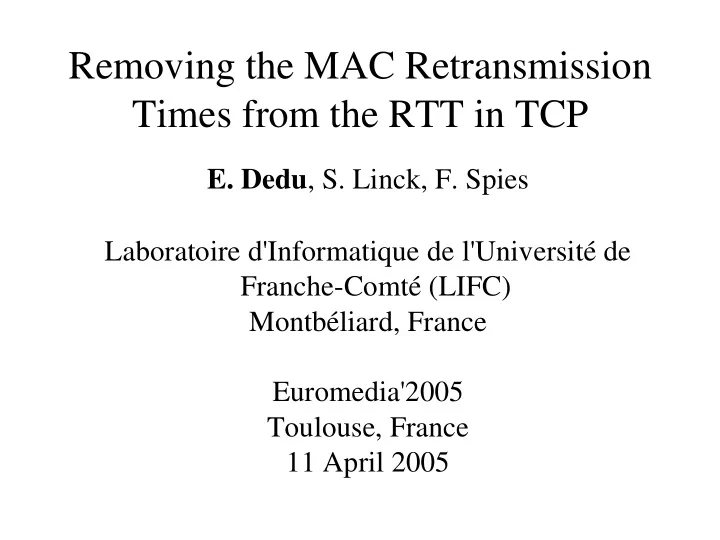

Removing the MAC Retransmission Times from the RTT in TCP E. Dedu , S. Linck, F. Spies Laboratoire d'Informatique de l'Université de Franche-Comté (LIFC) Montbéliard, France Euromedia'2005 Toulouse, France 11 April 2005
Problem: RTT modification ● TCP works very well in wired links S D – very few physical losses – most losses are due to network congestion ● TCP reduces packet rate, in order to eliminate congestion ● TCP is not adapted to wireless links <= interferences – short => MAC retransmissions => increase of RTT ● RTT as congestion indicator (queue length) is no longer appropriate ● RTO depends on RTT, it is falsely modified too – long => lost packets ● => inappropriate congestion control actions, since not congestion 2 / 14
Problem: RTT effects ● Several CC mechanisms use the RTT: – each RTT: TCP Vegas – the smallest RTT: Westwood+, TIBET – any solution where RTT might be used: RTP/RTCP over UDP ● TCP Vegas: for each packet reception, it compares its RTT against the estimated RTT: – if diff < , reduces rate – if < diff < , maintain rate – if diff > , increases rate 3 / 14
Proposition ● Put in packets the time spent on MAC retransmissions ● A TCP option is added ● Network cards have a timer ● Cards add to the TCP option the time lost in MAC retransmissions ● Receiver echoes back the time ● Source takes the appropriate action 4 / 14
Plan ● Principle – transmitting information to the source – retransmission time computing ● Simulations – ns2 modification – background: shadowing wireless propagation model – results ● Related work ● Conclusions, future work 5 / 14
Principle: transmitting information ● TCP option: – unit: 20 s – size: 2 bytes => 65536*20 s ≃ 1.3s ● 802.11b standard: max 1023 or retransmission window ● Source sets the field to 0 ● The field is modified by network cards ● Receiver echoes back the value of the corresponding data packet (exactly like timestamp option) ● Source receives the information ● => Incremental deploying possible 6 / 14
Principle: retransmission time computing ● Each network card has a timer ● For each packet: – when the packet is sent, the timer is initialised with the value of the TCP option – each time the packet is resent, the value of the timer is stored in the option => lost times are added Fixed src AP Mobile dest 0 -------------> 0 -------->X 54 ----------------> 54 X<----- 54 X<--------- 93 123<----------------- 123 7 / 14 123<------------- 123
Simulations: ns2 modifications ● Addition of the rets field to TCP header ● The sending part of TCP/Vegas ● The sending part of 802.11 – value used: the time between packet sending time and the reception of its MAC ACK ● Sending part of TCPSink ● Receiving part of TCP/Vegas ● All tests are available on Web page 8 / 14
Background: propagation models in ns2 ● All or nothing: ● Probability-based after a certain distance – FreeSpace – Shadowing <= used in the tests – TwoRayGround p=0 p=0 p=p(d) p=1 p=1 9 / 14
Simulations: results ● t < 5, ftp starts at 5s ● 5 < t < 100, identical ● 150 < t, 4.5% improvement max 1Mb/s ● 150 < t < 250, 15% improvement 10 / 14
Related work: general ● Packet loss in wireless: – [Jing et al. 2000], a timestamp is added by AP in each packet => can detect packet loss even for out-of-order packets => source is informed faster about packet loss ● RTT influence on RTO: – [Scharf et al. 2004], analytical model of RTO based on network parameters – [Möller et al. 2004], artificial delay at AP => RTT increases => RTO increases => false TCP retransmissions decreases => higher overall throughput 11 / 14
Related work: packet delay in wireless ● [Ratnam et al. 1998], AP divides the connection in two connections and estimates the packet delay ● Integrates within timestamp TCP option – timestamp granularity is machine-dependent ● => Each time a packet is resent, its timestamp is replaced with the most recent timestamp of the same flow – => estimation – => network cards: memory and CPU consuming ● Results: the more losses in wired part of connection, the higher the throughput 12 / 14
Conclusions ● A method to remove the effect of packet MAC delay ● Network cards have a timer which is added to the TCP option of the packet ● Receiver echoes back the value of the option ● Simulations: improvement of bandwidth 13 / 14
Drawbacks and future work ● Network cards have access to level 4 ● Deployment: source and destination (and AP) ● Restricted use (uses RTT) ● Analysis of more complex scenarios – competing flows in wireless – lossy wired links ● Real experiments (pb.: access the MAC firmware) ● If successful, define a complete proposal 14 / 14
Recommend
More recommend